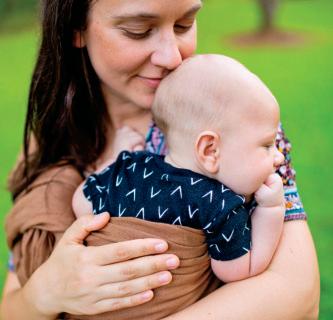
3 minute read
NEWBORN
The many benefits of babywear ing make the practice nearly irresistible. Here’s what parents need to know
NEWBOR N
Advertisement
TORONTO’S Allie Dennis requested a stretchy wrap and a buckle carrier when she was creating her baby registry. But once her son was born, she found she was too nervous to actually use them. “I didn’t know anything about how to use a carrier properly,” she says.
When her son was two months old, she joined a mom group where volunteer babywearing educators demonstrated how to use a variety of carriers. As soon as Dennis wrapped her newborn against her chest, she was hooked—so much so that shortly after, she trained to become a babywearing consultant herself, and opened Little Zen One, an online shop for carriers.
According to a study in the journal Pediat r ics, carrying your baby throughout the day can reduce crying by up to 51 percent. Using a carrier also allows you to hold your wee one while you do other activities, like prepare dinner, tidy the house, care for other kids or even just eat lunch. Many parents with babies who struggle to nap in their cribs find babywearing particularly helpful, as it allows them to hold their little ones for naps without being stuck in bed. Babywearing is also a wonderful way to bond with baby, especially for parents who aren’t breastfeeding.
Tanya Barrett, a paediatric physiotherapist in Toronto, says babywearing is incredible for your little one’s development. Babies spend quite a bit of time on their backs, which puts pressure on their heads and can lead to f lat head syndrome, torticollis and neck tension. When you wear your baby, that pressure is gone, and they can usually move their neck and head more freely. “The most important thing for babies’ development is being in a variety of positions,” she says, which babywearing can help facilitate.
Ready to try babywearing but don’t know where to start? Here are a few tips. WATCH AND LEARN Many parents learn how to use their carrier by following tutorials on YouTube or participating in one of the many Facebook groups dedicated to babywearing. PRACTISE It’s hard to master any new skill, especially one that involves corralling a wriggly baby, so practise before they’re born or during naptime, using a doll or a bag of sugar, beans, rice or potatoes. START SLOW Many babies fuss at first, but that doesn’t mean they won’t end up loving carrier life— they just need more time to get used to it. Feel free to pause before your carrier is fully fastened, support your baby with your arms and soothe them before continuing. If they don’t settle, just take a deep breath and keep going. Once they’re secure, start walking or bouncing, as babies find movement comforting and some babies will just cry until you get going. At first, aim for just a few minutes of babywearing at a time. FOCUS ON POSITIONING The main risks with babywearing are that a baby might slump down and rest their chin on their chest or that excess fabric could cover their airway, both of which can inhibit breathing.
Time to shop! There are many different styles of baby carriers and the best way to choose one is to try one on at a retailer or with a babywearing group or consultant. If you prefer, many consultants offer virtual appointments, where they can make sure you’re getting the best fi t over Zoom.
Your carrier should be positioned so that your baby is high on your chest, their head is close enough to kiss and you can see that their airway is clear. If you experience back pain or feel like you have to keep a hand on your baby for extra support, the carrier is too loose. Adjust your baby’s position if you hear them grunting, as they may be having trouble breathing. The other concern with babywearing is overheating. Dress your babe in only as many layers as you’re comfortable in and remember that the carrier counts as a layer, too.
Dennis is so glad she got into babywearning. “You’re meeting their needs while meeting your own,” she says. “What could be better than that?” —Avie Herman










